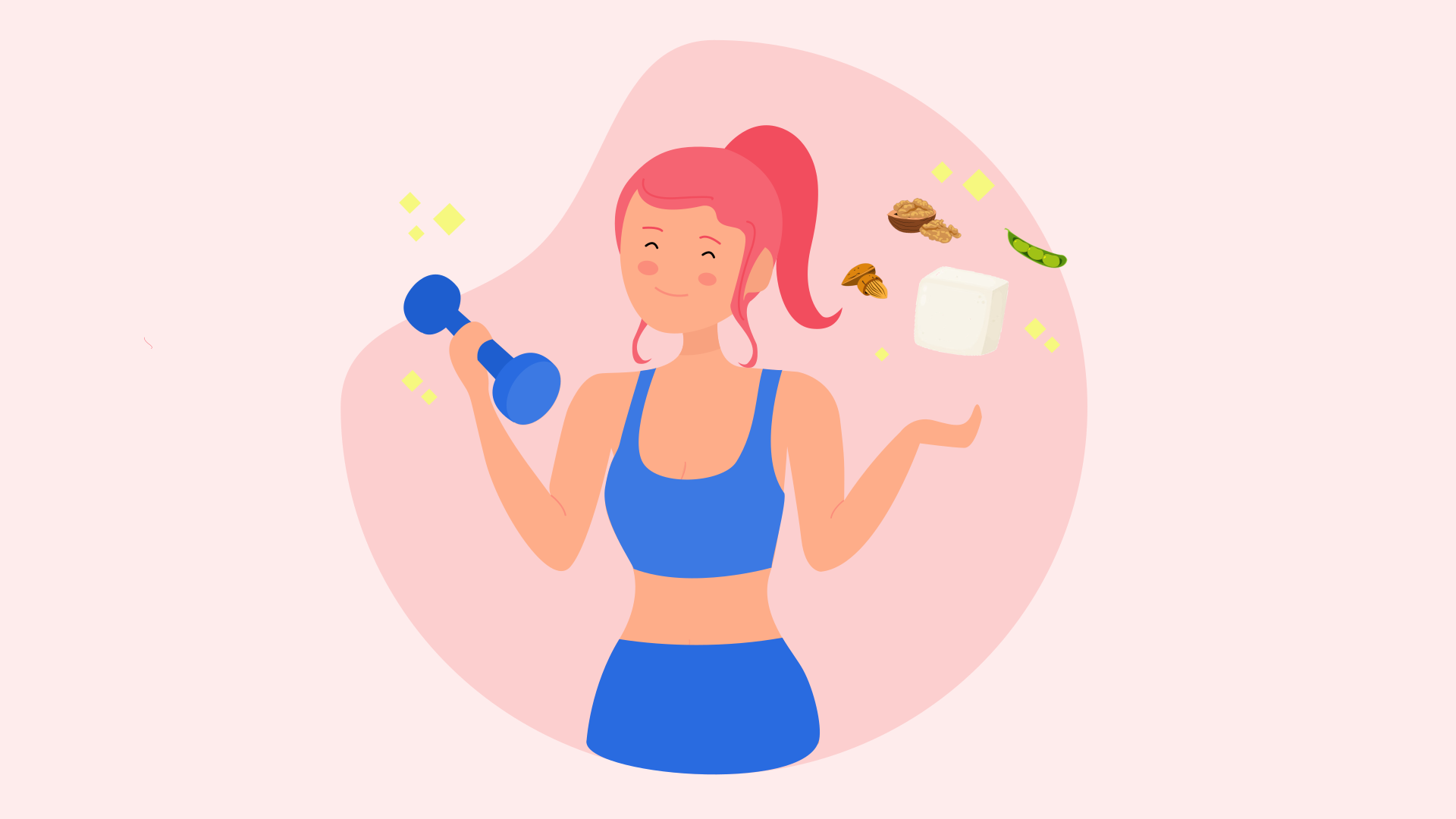In today's article, we'll talk about what's a high-protein diet and which plant-based foods are rich in proteins. Also, we'll share 11 delicious high-protein vegan lunch recipes for you to try, and we hope you'll find your new favourite!
Whether you want to lose weight, build muscle, or curb cravings, adding more proteins to your diet is a great way to start.
And with so many protein-rich plant-based foods to choose from, you can prepare delicious and satisfying meals to pack in your next lunch box.
You can skip right to the recipes using the table of contents below or keep reading if you want to learn more about the benefits of a vegan diet high in proteins.
How much protein should I have each day?
National guidelines recommend you should have 0.8g of proteins for every kilo of your body weight or 0.36 grams per pound.
This means that about 10% of your daily calories should come from proteins.
If you're a woman weighing between 50-60kg (110-132lbs), then aim for 40-48 grams of daily proteins. If you're a man of 70-80kg (154-176 lbs), your daily target should be around 56-64 grams of proteins.
However, increasing your daily proteins can help kick start your weight loss and also benefit your health in other ways, as many studies have shown.
In fact, scientists believe that a higher amount of proteins, about 1.3 grams per kilo (0.58 grams per pound), would actually be better for you[1].
Already, if you're an athlete, you're pregnant, or in advanced age, your daily protein needs increase to 1.2-1.5g per kg (0.54-0.67g per pound) to meet your changing body demands.
How much is a high-protein diet?
A high-protein diet provides at least 1.2 grams of proteins per kilo (0.54g per pound).
But it can go as high as 1.6 grams per kilo (0.72g per pound), which is double the recommended protein intake in a standard diet.
This means that in a high-protein diet about 20-30% of your daily calories are in the form of proteins.
If you're considering increasing your protein intake, you can easily calculate your daily proteins according to your body weight.
For example:
If you're a 60kg (132lbs) woman, aim for 72-96g of daily proteins.
If you're an 80kg (176 lbs) man, aim for 96-128g of daily proteins.
It's very important to distribute your proteins evenly throughout the day for maximum benefit and to avoid risks.
When're you on a high-protein diet, make balanced meals that include a variety of foods, spreading out your daily proteins equally among them.
If you consider that you have 4 daily meals, that is, breakfast, lunch, dinner, and two snacks, then this is how many proteins each meal should have in a high-protein diet:
18-23g for a 60kg (132lbs) woman
24-32g for an 80kg (176 lbs) man
What are the benefits of a high-protein diet?
Following a high-protein diet is great if you're overweight and want to lose weight or if you're physically active and want to improve your performance.
Also, a diet high in proteins can offer other health benefits besides supporting dieting and fitness.
So, let's look in more detail at the advantages of a high-protein diet for weight loss and why it could be a good choice for you.
Following and succeeding in a weight loss diet can be hard, but a few tricks can help. Increasing your protein intake is one of these. For two reasons:
Proteins have the power to suppress hunger for hours after you eat.
That's because they take longer to digest and also regulate those hormones that make you hungry.
So, adding high-protein foods to your diet will make you feel full for longer and consume fewer calories throughout the day.
Proteins can increase your body metabolism.
Your body will need to burn more energy (thus calories) simply to break down, absorb and use the proteins you eat.
This effect, called the thermic effect of food, is much higher with proteins than with carbs or fats and can make you burn an extra 100 calories[2]. Cool!
Another cool thing about consuming more proteins is that they will help grow and maintain your muscle mass.
A high-protein meal helps repair muscle after a workout and build muscle mass.
This is great news for gym-goers! Next time you'll hit the gym, your muscles will be stronger, and you'll be fitter.
Where do vegans get proteins from?
If you thought vegan diets lack proteins, you'd be surprised to know that there are plenty of plant-based foods that provide all the proteins you need.
Vegans can get their daily proteins from a variety of foods, such as:
Legumes like soybeans, lentils, chickpeas, and peas;
Seitan, a meat alternative made from hydrated gluten (the main protein found in wheat);
Soy products like tofu, tempeh, soy yogurt and soy milk;
Nuts and seeds like peanuts, almonds, pumpkin seeds, chia seeds and hemp seeds;
Pseudocereals like buckwheat, amaranth, and quinoa;
Cereals like oats, spelt, teff, wheat.
Even some vegetables like broccoli, spinach, corn and Brussel sprouts contain a fair amount of proteins.
Many plant-based sources of proteins also provide fibres, healthy fats, antioxidants, vitamins, and minerals.
Opting for plant-based proteins in a high-protein diet can help you make the most out of both worlds.
Many studies have shown that vegans tend to have lower body weight, body mass index and cholesterol[3]. If you couple this with the health and weight-loss benefits of a high-protein diet, you've got the recipe for a healthier you.
How can vegans get complete proteins?
You might have heard about the importance of consuming complete proteins, especially in vegan diets. But what exactly are they?
Foods with complete proteins contain all the nine essential amino acids, the building blocks of proteins that your body can't make from scratch and needs to function properly.
While it's true that animal proteins contain a good balance of all the essential amino acids, it's also true that you can find plant-based foods with complete proteins.
These include soybeans and soy products like tofu and tempeh, but also amaranth, quinoa, buckwheat, hemp and chia seeds, and nutritional yeast.
Moreover, you can mix and match different foods to get complete proteins too. For example, think about combining rice with beans, peanut butter with brown bread, or hummus with pita.
Pairing nuts and cereals or legumes and cereals helps you get complete plant-based proteins.
However, as long as you eat a varied and balanced diet, you should be able to get all the amino acids you need. So I wouldn't stress too much about carefully counting complete proteins in your meals. Rather, make sure you are eating lots of different plant-based foods.
High-protein vegan lunch recipes
Here is our fabulous collection of 11 high-protein vegan lunch recipes, which we hope will inspire your next meal.
We carefully selected them for you to include good sources of plant-based proteins. Also, we matched the recipe protein count with that of a high-protein diet meal.
We considered a range of 18-23g of proteins per meal for a 60kg (132lbs) woman and 24-32g for an 80kg (176 lbs) man.
These lunch recipes are super easy and quick to put together, perfect for your weekly meal prep. Not to mention, they're packed with flavour and nutritious ingredients.
Let's have a look at them together!
Harissa Pasta Salad
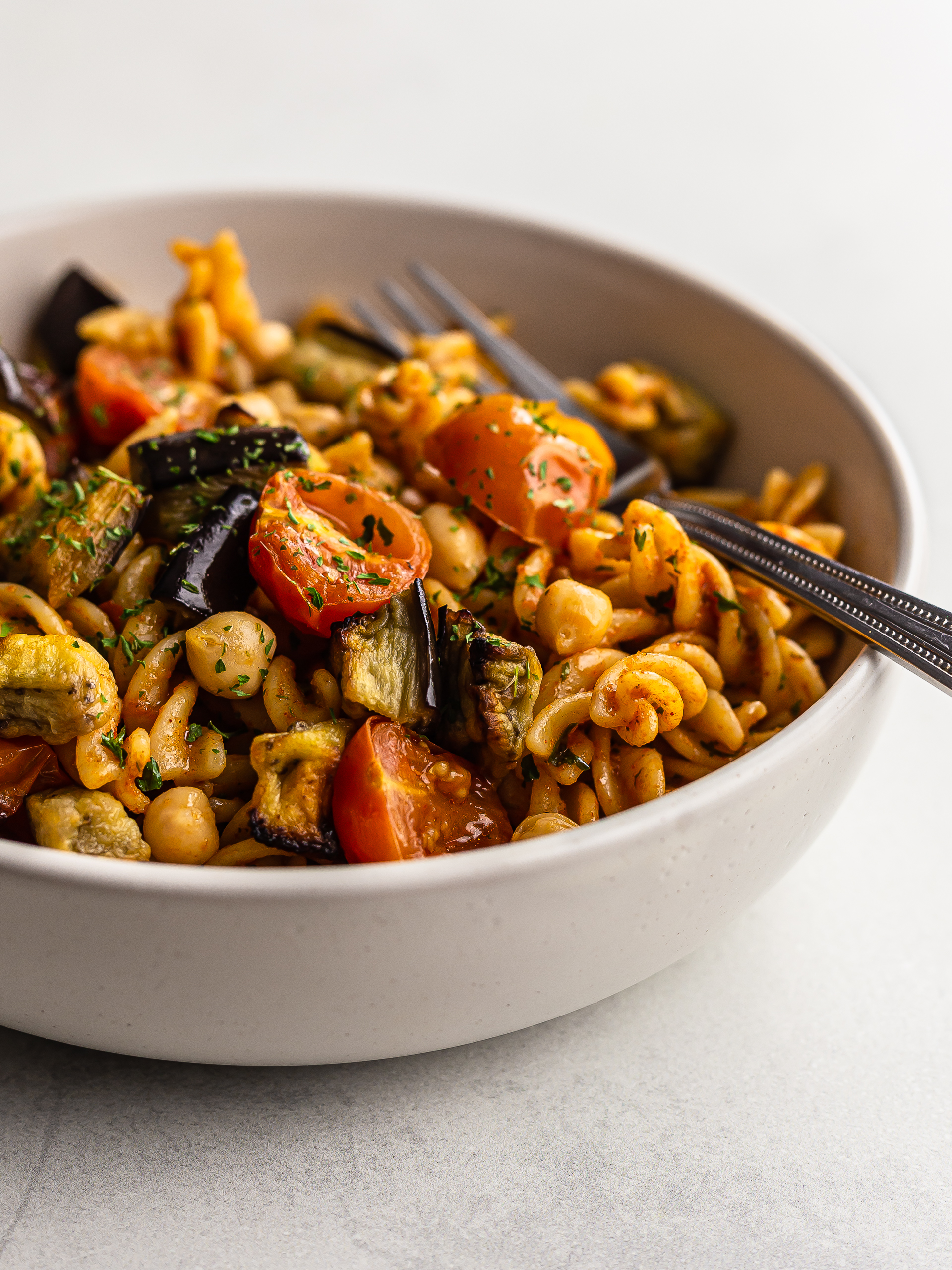
Protein count: 18g
Give your pasta salad a Middle Eastern spin using spicy and aromatic harissa paste.
The combo of wholemeal pasta and chickpeas makes sure you'll get complete proteins, 100% plant-based.
Glass Noodle Pad Thai
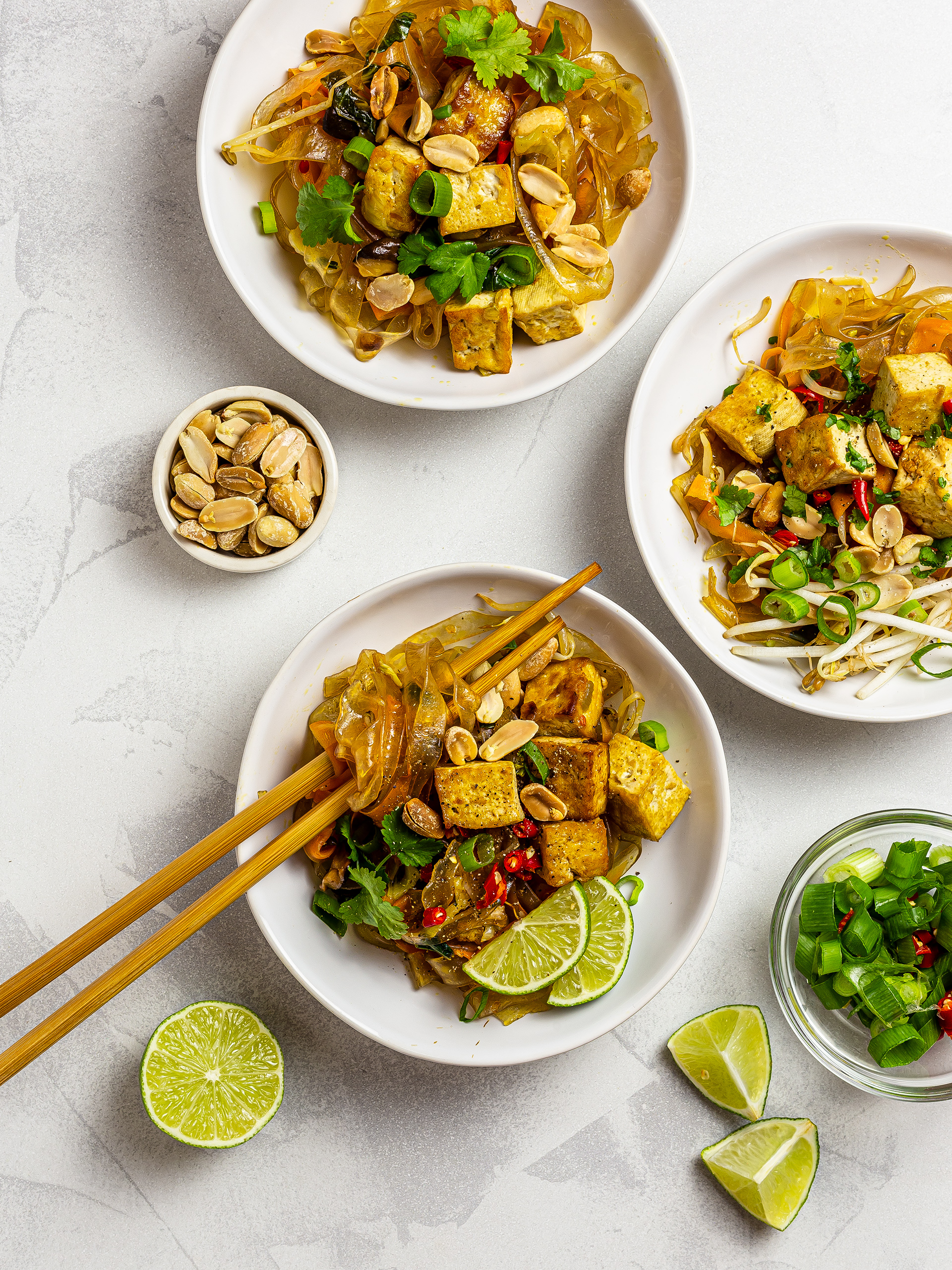
Protein count: 19g
Here, pad woon sen meets pad thai — aka stir-fried glass noodles with veggies, bean sprouts, and peanuts.
It's fresh, spicy, savoury and deeply satisfying. Not to mention, ready in 30 minutes.
Diced tofu and toasted peanuts top it up with awesome vegan proteins.
Creamy Peas Pasta

Protein count: 20g
Another fantastic pasta recipe that's as easy to make as it's good for you.
You'll get proteins from wholemeal wheat, proteins from green peas, and even proteins from broccoli. Oh, yes!
It's not just high in proteins, but it also packs over half of your daily fibres. After one filling bowl, you'll be happy and satisfied for hours — goodbye afternoon cravings!
Edamame Nasi Goreng

Protein count: 21g
Say hello to our mouthwatering vegan take on the classic Indonesian stir-fried rice. Same flavour, but only plant-based goodness.
To boost those proteins, we've included a combo of edamame beans, toasted peanuts, and brown rice.
It's a satisfying and colourful dish that will put a smile on your face, and your belly too. Try it!
Tandoori Gobi Salad

Protein count: 20g
Who says that you can make tandoori only with chicken? Glazing cauliflower florets with spicy Indian sauce is a fantastic way of eating more of this glorious veggie.
Don't worry — it's a vegan recipe but not only about veggies.
Soy yogurt, quinoa, and chickpeas ensure you'll stay on track with your protein count and enjoy a well-balanced meal.
Spicy Kale Edamame Salad
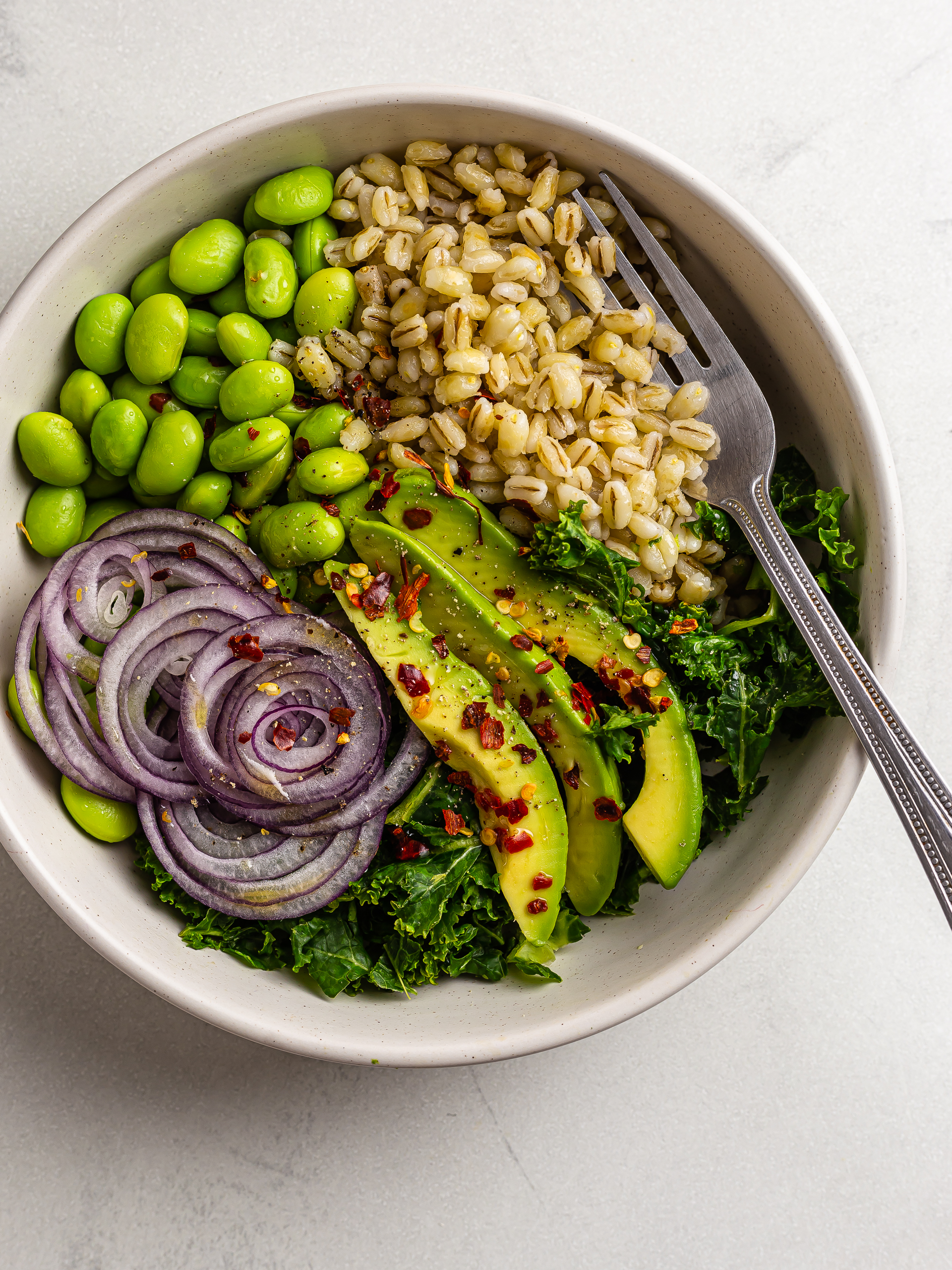
Protein count: 21g
Here is another wonderful dish with mighty edamame, the king of plant-based proteins.
It's one of those recipes that's so simple to make it'll be ready before you know it.
Check the recipe below, and we'll show you a trick to make raw kale both soft and easy to digest.
Broccoli Buckwheat Salad

Protein count: 21g
This tasty lunch salad checks all the right boxes for a well-balanced and high-protein vegan meal.
Buckwheat is one of those pseudocereals like quinoa that you don't want to miss if you need complete plant-based proteins.
Find out how to cook it in our recipe below, and turn it into a glorious lunch box meal you'll actually look forward to!
Spicy Lentil Burger
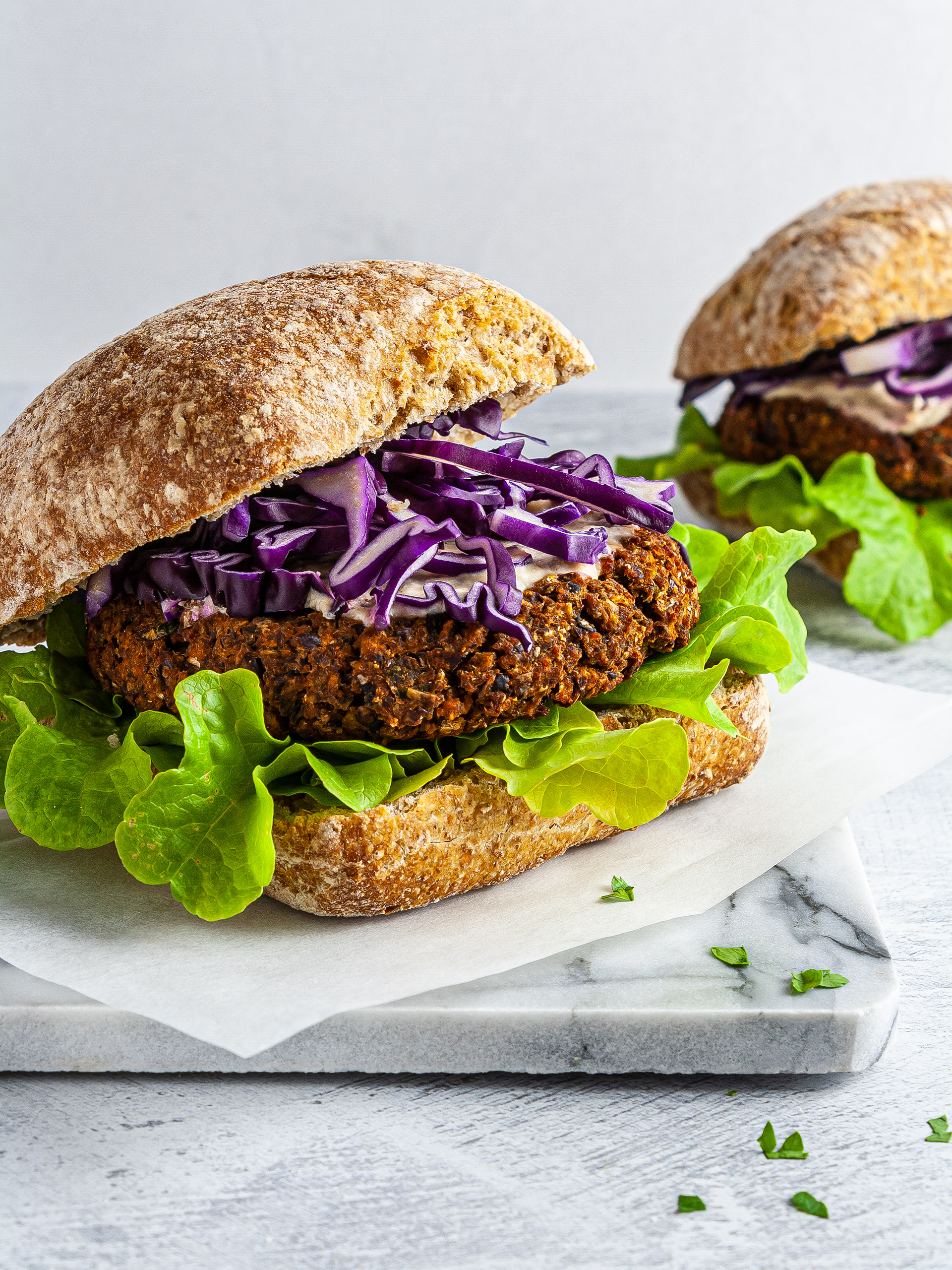
Protein count: 21g
For those days when you crave a satisfying lunch sandwich, this all-bean burger will deliver.
We made it with carefully selected ingredients to bring back those nutrients you'd normally get from meat.
You can prepare it at dinner and pack it for the next day, so you'll have your next two meals already sorted!
Moroccan Cauliflower Rice Bowl
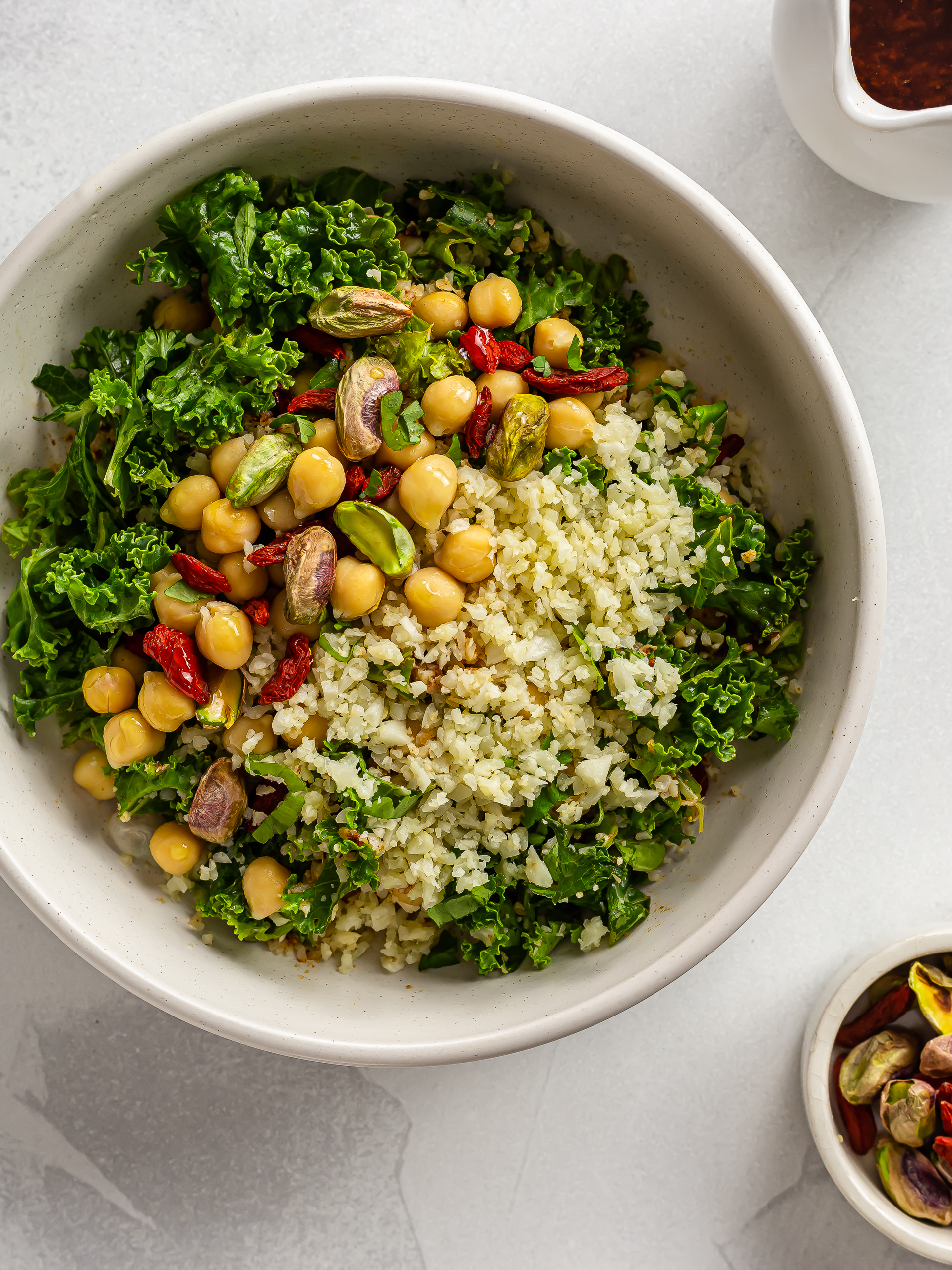
Protein count: 22g
If you want a tasty vegan lunch that's high in proteins and also cuts back on carbs, you'll love this recipe.
Cauliflower rice is the new low-carb rice you have to try. And it's so easy to make! Just follow our recipe below.
Our warming Moroccan dressing gives this salad bowl so much flavour you won't even taste the cauliflowers.
Red Lentil Mushroom Pasta Salad
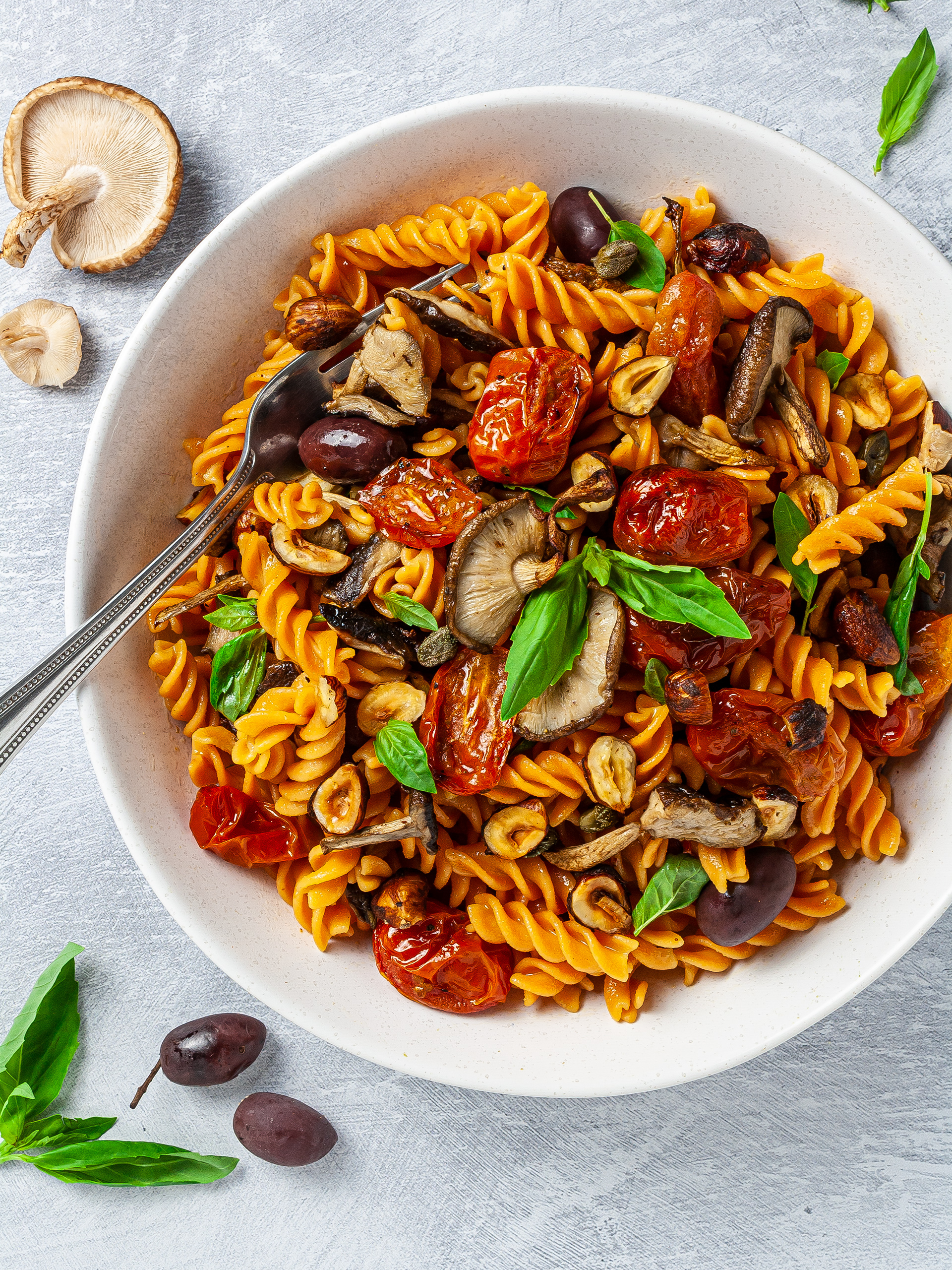
Protein count: 26g
Red lentil pasta is a great alternative to wheat pasta for those who can't have gluten.
Here, we used it to boost our recipe with lots of plant-based proteins.
Imagine that 100g (3.5oz) of dry red lentil pasta has almost 30g of proteins. Wow! Not to mention, it tastes so good!
Miso-Marinated Tofu Bowl

Protein count: 30g
For the grand finale, here is a fabulous tofu bowl that will meet your most demanding protein needs.
If you like soy, this is the recipe for you. We chose not one, not two, but three soy products to give you a high-protein lunch you'll love.
And if that wasn't enough, we topped the dish with brown rice and sesame seeds for even more plant-based proteins.
Takeaway
You should now know more about the ins and outs of a high-protein diet and quality plant-based proteins.
We hope that one or two new recipes in our list tickled your tastebuds and that you'll give them a try for your next lunch.
And if you're looking for more inspiration, you can use our recipe search engine. A free tool that lets you filter out the hundreds of recipes on the site according to allergens, diets, nutritional macros and more. Check it out!
Have a wonderful day!

